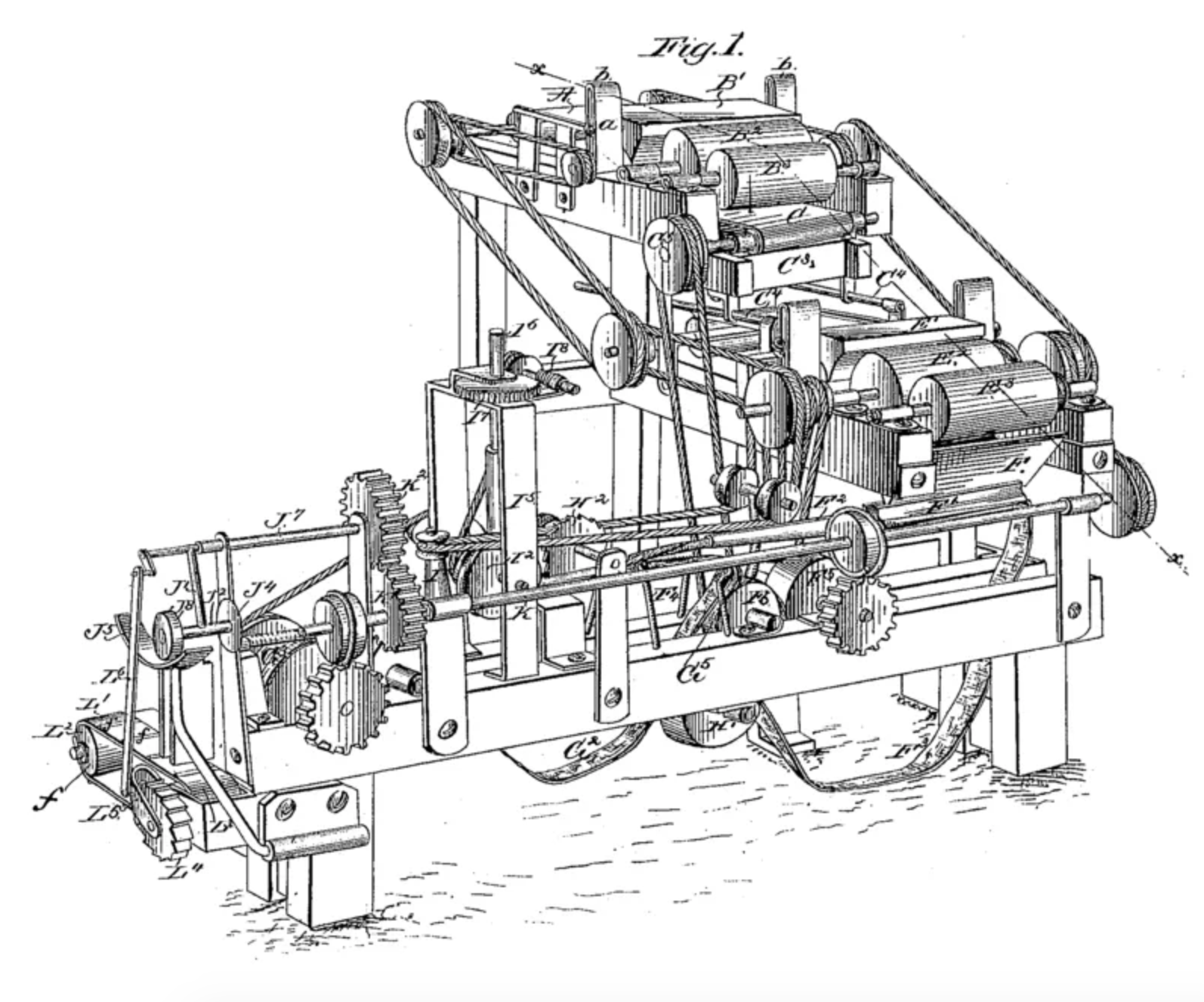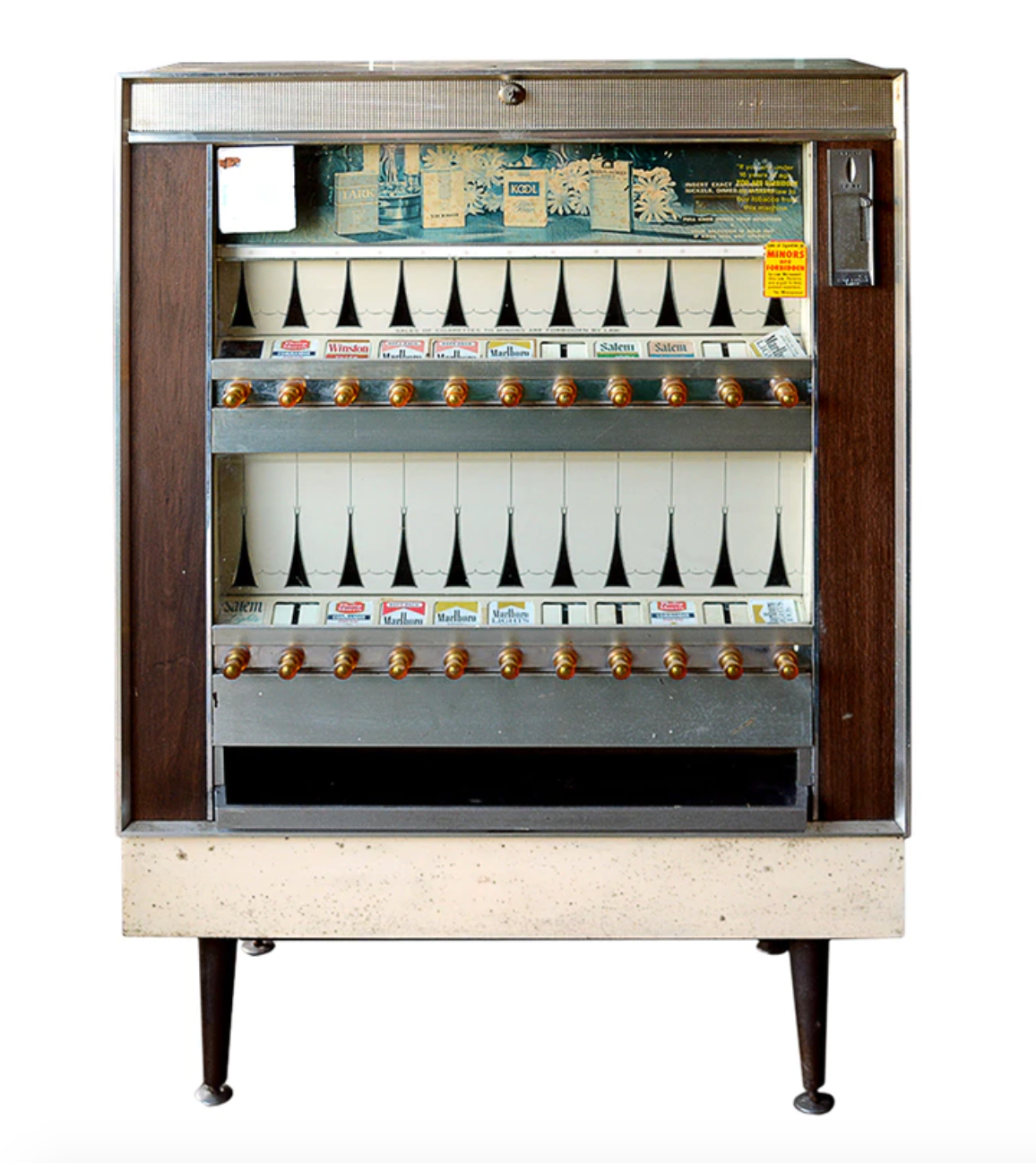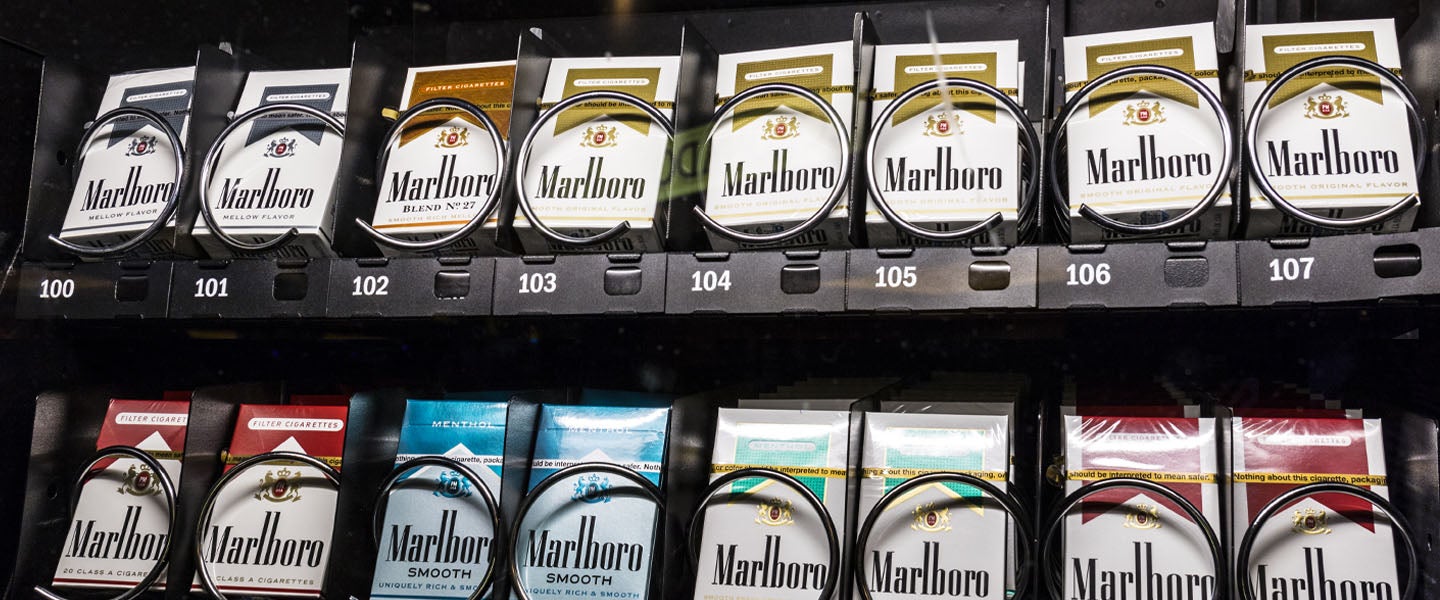If you check out #cigarettemachine on Instagram, you’ll find a handful of different kinds of posts: collectors of coin-operated machines sharing their latest haul; people overseas surprised to find cigarette vending machines still in operation; and people here in the U.S. marveling at the fact that they’ve found one in the wild.
While I’m not a smoker, even I’ll admit that posts tagged with #thesestillexist is a sad fall for a machine that used to be just about anywhere — especially in bars. In fact, as late as the 1990s, you’d almost never be able to find a bar without one. As Michael Wilson wrote in the New York Times, “There once existed in every city barroom a sort of scruffy, lively, lovely symphony that played without rest and without ovation. It played all night: thunk, thunk, thunk, as the coins dropped into the slot, followed by the grinding crank of unseen gears as the rod was yanked out. The short solo ended modestly, like a tap on a high hat, with the whisper of a pack of smokes wrapped in plastic film sliding into the tray below. The cigarette machine.”
Before we get to the heyday of the cigarette machine though — and its eventual, inevitable decline — it makes sense to back up a little bit, to the early part of the 20th century, when the coin-op business as a whole was booming. We previously talked about the condom machine — that prophylactic-packed vending device stocked by the self-titled “rubbermen” of yesteryear — as well as the early days of the claw machine, but these devices were all part of a bigger trend, a time where just about everything was put into vending machines, cigarettes included.
The inventor of the cigarette machine as we know it was a guy named William Rowe, who was a clerk for the L.A. police court. As explained over at Daniel’s Antiques, “Always the innovator, Rowe would take home odds and ends that were confiscated by the police. In 1926, Rowe invented the world’s first automatic vending machine for cigarettes using a confiscated moonshine whiskey still and a cigar box. In 1928, with Robert Z. Greene, Rowe founded the Rowe Manufacturing Company, Inc. in L.A., the first company in the U.S. to manufacture cigarette vending machines.”

While this is all true, Jim, an antique coin-op collector who specializes in cigarette machines, explains that although Rowe was the first guy to vend packs of cigarettes, the doling out of single cigarettes did predate that, and you used to be able to buy a single cigarette for a penny.

The loosie business was short-lived, however, dying out in the 1930s in favor of buying cigarettes by the pack. Not long after Rowe invented his machine, they took off and grew quickly, thanks to an America that was growing more and more addicted to cigarettes. As Vox explained in their history of the cigarette industry, smoking cigarettes in the country grew wildly popular in the early 20th century thanks to the invention of the cigarette rolling machine.

As Vox explains, “Prior to 1880, cigarettes were rolled by hand, which meant a rate of only a few cigarettes per minute. Things changed significantly in 1880, when James Bonsack invented a machine that could roll 210 cigarettes a minute, or 20,000 cigarettes in 10 hours.” When this change happened, suddenly the supply of cigarettes way outweighed the demand, so this meant tobacco manufacturers had to create demand, and they sure as hell did.
Thanks to the new technology, cigarettes suddenly became way cheaper. Additionally, they were marketed as much more sanitary — and healthier — than other forms of tobacco use. Looking at the numbers from the Department of Agriculture, while cigarettes accounted for only a tiny part of tobacco sales in 1900, by 1930 they were outselling every other form.

But for a brief dip during the 1930s thanks to the depression, cigarette sales — and tobacco as a whole — would rise steadily until the 1950s. They wouldn’t begin to significantly decline until the 1970s.
Rowe and others making cigarette vending machines would be along for the ride, hitting the wave of an increasingly addicted America as well as the rise in the vending machine business as a whole. The machines during this time were tall, sleek and with a heavy art-deco influence. They often had a mirror on the front of them too, which, as one collector explained to me, had to do with the machine’s placement within a business. They were usually put near the bathrooms of bars and restaurants, since these lavatories were often so small that they lacked the “amenities” that many of today’s public restrooms have (like, say, sinks and mirrors). And so, the mirror on the cigarette machine, right outside the bathroom, would provide a convenient moment to check yourself out — and of course, remind you that you were craving a smoke.
While show business is widely regarded as the only business to do well during the Great Depression — thanks to a need for escapism — the vending machine business also grew, and was one of the very few industries to do so. Vending machines became so prominent that a new type of restaurant known as an “automat” appeared — basically a big cafeteria with little to no attendants in sight, just rows and rows of vending machines, which doled out meals, desserts and — of course — cigarettes. The automats proved wildly popular, sticking around until about the 1970s, when they’d eventually decline in popularity.

The vending machine boom would come to a complete halt, though, on December 7, 1941. When Pearl Harbor was bombed, America went to war, and the vending machine business practically shut down overnight as men were shipped overseas and factories were re-allocated for wartime causes. During this time, the machines still existed, but as Jim notes, they stopped being made pretty much entirely.
As it would turn out, though, the war would be the best thing to happen to the vending machine business, which would soar to even greater heights after the conflict ended and the American manufacturing industry as a whole began to explode. “Following the worldwide destruction from World War II, much of the modern world was devastated,” explains Tim Sanford, editor of Vending Times and a man who’s been with the publication for over 50 years. But aside from Pearl Harbor, America remained physically untouched. Leaning hard into this advantage, Americans went to work like never before, supplying the rest of the world with goods as it got back on its feet.
To keep up with demand, these factories were often running 24/7, and while a guy could maybe duck out at noon for a break to grab some lunch, that wasn’t the case for the overnight guy. Some places had cafeterias and food vendors in-house, but even they were hard to staff on weekends and overnight. “Vending machines came to the rescue,” Sanford says, explaining that factories began to have a variety of vending machines in house. And while today we may think of vending machines primarily housing snacks and sodas, back then there were ones with cold sandwiches, hot sandwiches and coffee, stocked daily with new stuff.
During this time, people were also smoking like never before, so cigarette machines were also everywhere: at work, in grocery stores, in bars and in restaurants. You never had to go without a smoke. In the mid-1960s, however, the cigarette vending machine business took two major hits that it would never recover from. First, it was during this time that much of the world had recovered from the ravages of war, so the U.S. no longer supplied the world single-handedly — with vending machines taking a hit, too. Second, and more important to cigarette machines specifically, in 1964, the surgeon general warning was first placed on cigarettes.
Sanford explains that the “last great cigarette vending machines” came about around the early 1980s. By this time, they were offering upwards of 40 brands and were a good deal more electronic than mechanical. But while an increasing selection was good news for smokers attached to a particular brand, it was sometimes bad news for operators, as they’d now have to repair circuit boards as opposed to mechanical parts, which was considerably different.
Electronics also posed another problem for one particular kind of operator: the mob. While the vast majority of vending machine operators were run-of-the-mill, honest business owners without criminal ties, it was a particularly attractive industry to organized crime, since it was an entirely cash business. “It was a money-laundering operation for them,” Sanford explains. Not only was this a way to hide where the money was coming from, in many cases, coin-op machines didn’t even dole out a physical product — jukeboxes and coin-op pool tables, for example, didn’t sell anything tangible, so there wouldn’t even be a question of sales versus supply. As for the cigarettes, while there was a physical product there, cigarette machines went hand-in-hand with juke boxes and pool tables — as they were often placed in bars — so the mob often dealt in them too. Still, the mob were hardly the driving force of the business. “It’s true that organized crime was sometimes linked to the vending machine business,” Sanford admits, “but it’s always been blown way out of proportion.”
The mob would fade out of the vending machine business entirely when things became less mechanical in the 1970s and onward, as Sanford explains that anything that kept a record of sales could no longer be used to launder money. This would be a gradual process, though, as the electronic machines never really became all that widespread thanks to the decline of smoking in general. Instead of getting replaced, the “classic” cigarette machine — the ones with the glass front and the pull rods — would end up being the models that would stick around much longer, as they were considerably more robust.

Thanks to the campaign against smoking, which began in earnest in the 1960s and grew more and more powerful as each decade went on, cigarette machines became less common in places like grocery stores and eventually even restaurants. Concerns that children could more easily buy cigarettes from a machine than they could a store became a rallying cry throughout the 1990s, taking a huge chunk out of the cigarette vending machine business. Even so, their decline took decades, as evidenced by this video from the mid-1990s, when A&P grocery stores announced it would no longer sell cigarettes from vending machines in any of its stores.
Demise of cigarette-vending machines
UP IN SMOKE! Twenty-two years ago this week, A&P supermarkets banned cigarette-vending machines from their stores. In the years since, they have all but vanished everywhere. When's the last time you saw an old-school cigarette machine?
Posted by Antenna TV on Monday, July 9, 2018
Another major challenge these machines faced was the ever-rising cost of cigarettes, as each time the price went up, the machine had to be retro-fitted to house more money. Eventually, with cigarettes reaching $10 a pack or more, no one would ever really have that many quarters on them, so that also hurt the business.
Increasingly, cigarette machines began to only be found in bars, and even then, some bars couldn’t have them if they were an establishment that let children in. This was because many statewide bans — including New York’s — forbid the presence of a cigarette machine in any establishment where any kid would ever be allowed in. Some other places went even further, banning them outright, with no exceptions whatsoever. In 2002, New York City banned smoking in bars and restaurants — many other cities would enact similar laws around the same time. With people unable to smoke, more vending machines went away as a result.
As for what became of the machines themselves, Sanford explains that most of them ended up in the scrapheap, traded in for their metal more than anything else. While there are some collectors like Jim out there, there are far more cigarette machines than there are guys willing to pay for them, so, for the most part, Sanford says, “those machines are usually given away.”
One of the guys they’re given away to is an artist by the name of Clark Whittington, who created something in 1997 known as the Art-o-mat. “I’m a conceptual artist,” explains Whittington, “so a lot of my art is based on experiences and observations, things like that. Anyway, in the late 1980s, I had a friend who was an ex-smoker and he had this Pavlovian response to the wrinkling of cellophane which made him crave cigarettes. This would happen to him whenever he would go to a snack machine, and this was the first time the idea popped into my head to put art in a vending machine.”

At first, Whittington just jotted the idea into his sketchbook and left it at that. It wasn’t even cigarette vending machines that we was thinking of, as he’d envisioned more of a snack machine, as they could hold a variety of sizes. The idea sat unrealized for about a decade until 1997, when Whittington moved to Winston-Salem, the home of much of the cigarette industry.
“I never thought I’d live in Winston-Salem, but my wife got a job here and that’s why I’m here. Back in 1997, a friend of mine saw my sketchbook and asked, ‘What’s that?’ I told him that one day I’d like to put art in a vending machine. He then suggested putting it in a cigarette machine. At first I thought it was a weird idea, but he insisted, saying that they’re practically giving them away,” Whittington says.
From there, Whittington acquired his first cigarette machine, polished it up and put the name “Art-o-mat” on it. The art inside was all his (mostly Polaroids, as that was his preferred medium at the time). He put the machine in a local coffee shop that doubled as a gallery. It was just one of 13 pieces of his that was being displayed for the week, but at the conclusion of his show, the coffee shop asked him to keep it up. Soon, to keep up with the demand, he began stocking it with other people’s artwork, too.

Thanks to its innovative use of a cigarette machine in a town synonymous with cigarettes, the Art-o-mat received a lot of local press and more and more people wanted one. “It’s continued like that ever since, for the past 22 years,” Whittington explains. Now there are 170 Art-o-mats all around the world with at least one in almost every state and in three continents.
I even discovered that there was one not far from me, in Rye, New York, so I ventured the hour there to buy something from an Art-o-mat for the first time.
Over time, Whittington came to understand that the Art-o-mat benefits from the limitations of the cigarette machine. See, when cigarette machines began to decline, there was practically nothing else they could be used for due to the size of a pack of cigarettes. Manufacturers had had a hard enough time retro-fitting the machines every time the price went up on cigarettes, so when the machines were in decline, there was really nothing else to do but throw them out. Whittington explains that that distinct size became an unexpected asset to him. “When you see a piece of art that’s that size, you know it came from an Art-o-mat, and that’s really cool,” he says.
He adds that nostalgia has also played a part in his success. While his intention with the Art-o-mat was to provide original artwork in a way that’s fun and accessible to the masses, he’s discovered that for many ex-smokers, buying a piece of art from an Art-o-mat provides something of a trip down memory lane where one can deposit their money, pull that rod and get something wrapped in cellophane, enjoying all the same sense memories that one might’ve felt decades ago.
Except for, y’know, the cancer part.

